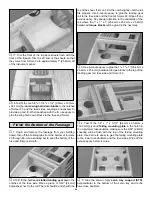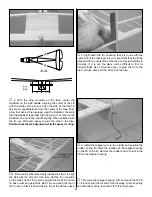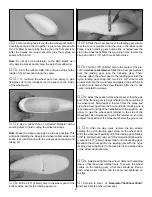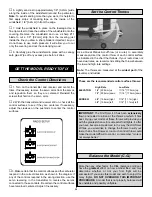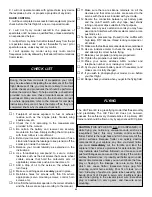
Remove the engine, landing gear, pushrods and control
horns. Fill any scuffs and dings with balsa filler or by
“expansion.” See the
Expert Tip below. After the filler has
dried, use progressively finer grades of sandpaper to even
and smooth all the edges, seams and surfaces. Sand a
radius along the bottom and top edge of the fuse. Remove
all the balsa dust from the model with compressed air, a
tack cloth or a vacuum with a brush.
The Old Timer 40 does not require much painting to obtain
the scheme shown on the box, as most of the finish is done
with Top Flite MonoKote covering. The only painting required
is the windshield frame and wheel pants.
The technique we will describe here is how the model
pictured on the box was finished.
Cover the model with Top Flite MonoKote film, using the
sequence that follows. The use of a Top Flite MonoKote Hot
Sock
™
on your covering iron will prevent scratching the
MonoKote film.
Before you cover the fuselage, first apply 1/4" wide strips of
white MonoKote film in the corners where the stab and fin
meet the fuselage and each other. Proceed to cover the stab
with pre-cut pieces that meet in the corners and overlap the
1/4" strips. Do not, under any circumstances, attempt to
cut the covering on the stab after it has been applied
except around the leading and trailing edges and the
tips. Modelers who do this may cut through the covering
and into the stab. This will weaken the structure to a point
where it may fail during flight.
COVERING AN OPEN STRUCTURE WITH MORE
THAN ONE COLOR OF MONOKOTE FILM
A problem some modelers have when covering with more
than one color of film is that air bubbles can become
trapped in the seam between the two pieces of film. This
becomes a big problem when covering over an open
structure.
The procedure that was used to cover the Old Timer 40
uses a template made from paper for the white and
transparent blue covering. The transparent blue template
was drawn approximately 1/4" [6.4mm] larger than
needed. A piece of transparent blue MonoKote film was
laid on a piece of glass that was lightly wetted with a glass
cleaner such as Windex
®
. A squeegee wrapped with a
paper towel was used to remove the glass cleaner from
under the covering film. The transparent blue film should
now be flat on the glass. Tape the template, for the
transparent blue film, on top of the film. Use the template
as a guide to cut the film.
Follow the same procedure to cut out the white film.
Again, with the transparent blue film flat on the glass,
position the white film so that it overlaps the transparent
blue film by approximately 1/4" [6.4mm]. With a covering
iron set close to high, iron down the seam between the
two colors.
Allow the covering to cool for a minute and carefully start
lifting one end of the white covering. The two pieces
should be connected along the seam. If they are not,
increase the heat of the covering iron and repeat the
process. It may require more heat than normal for the film
to seal caused by the glass absorbing some of the heat.
After removing the film from the glass, position the film on
the structure. Use a covering iron to tack the film down
every few inches. Then go back and seal the covering to
the wood all over.
A heat gun can be used to shrink the covering, but care
must be taken to not pull the seams apart.
Cover the Model with Top Flite
MonoKote
®
Film
Many surface blemishes on a framed model are caused
by bumps and balsa chips on the work surface. This type
of “ding” is best repaired by applying a drop or two of tap
water to the blemish, then running a hot sealing iron over
the spot to expand the wood fibers. After the surface has
dried, sand the expanded area smooth.
Final Sanding
FINISHING
36
Summary of Contents for Old Timer
Page 6: ...6 DIE PATTERNS...
Page 7: ...7 DIE PATTERNS...
Page 44: ...TWO VIEW DRAWING Use copies of this page to plan your trim scheme...
Page 45: ...B C...
Page 46: ...D A...





